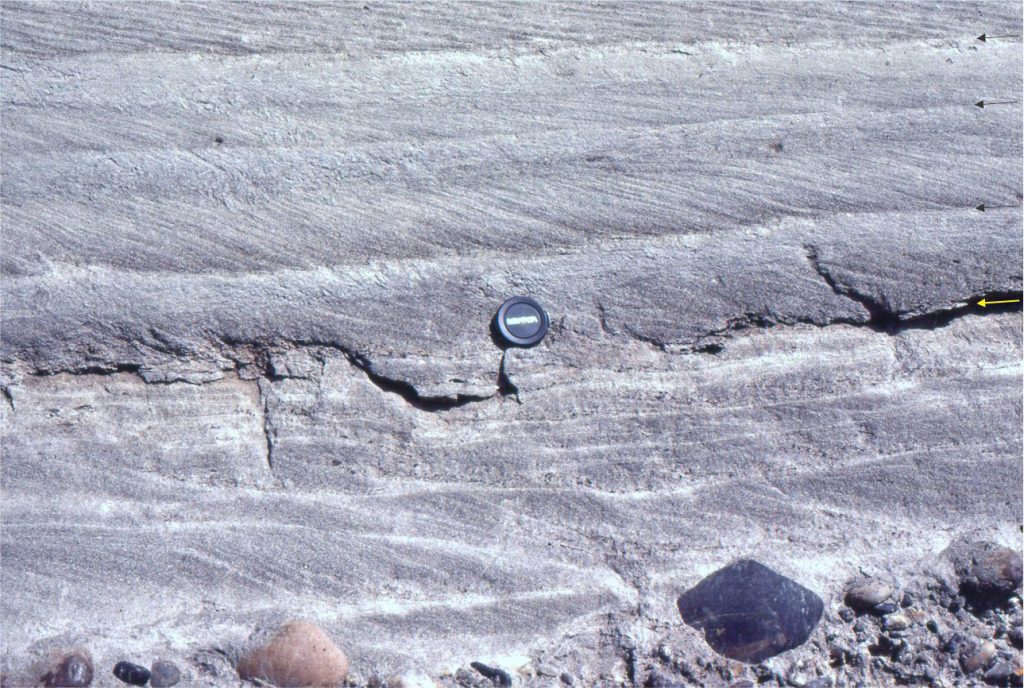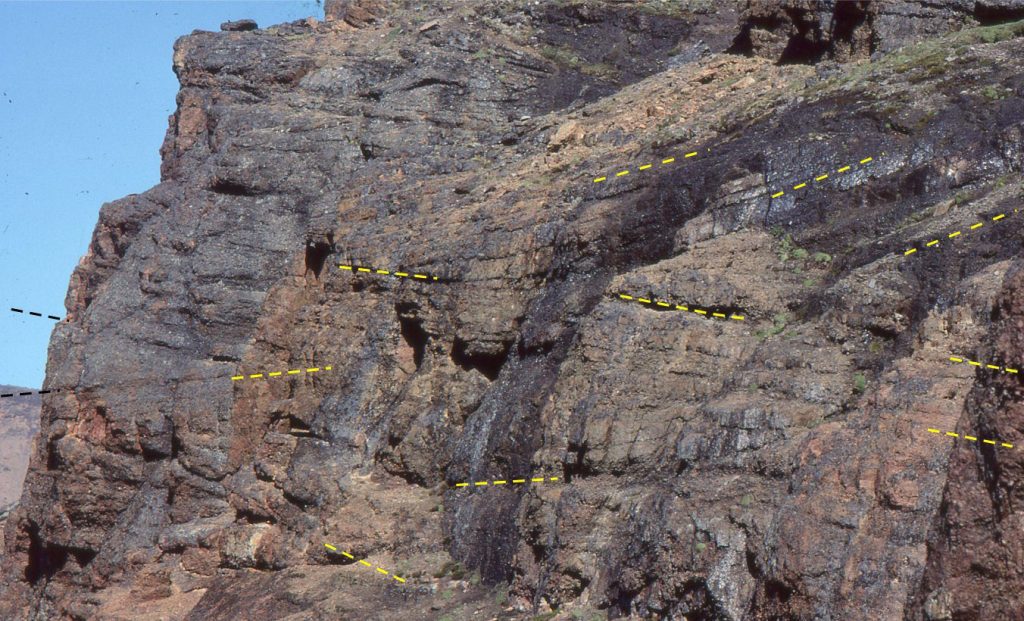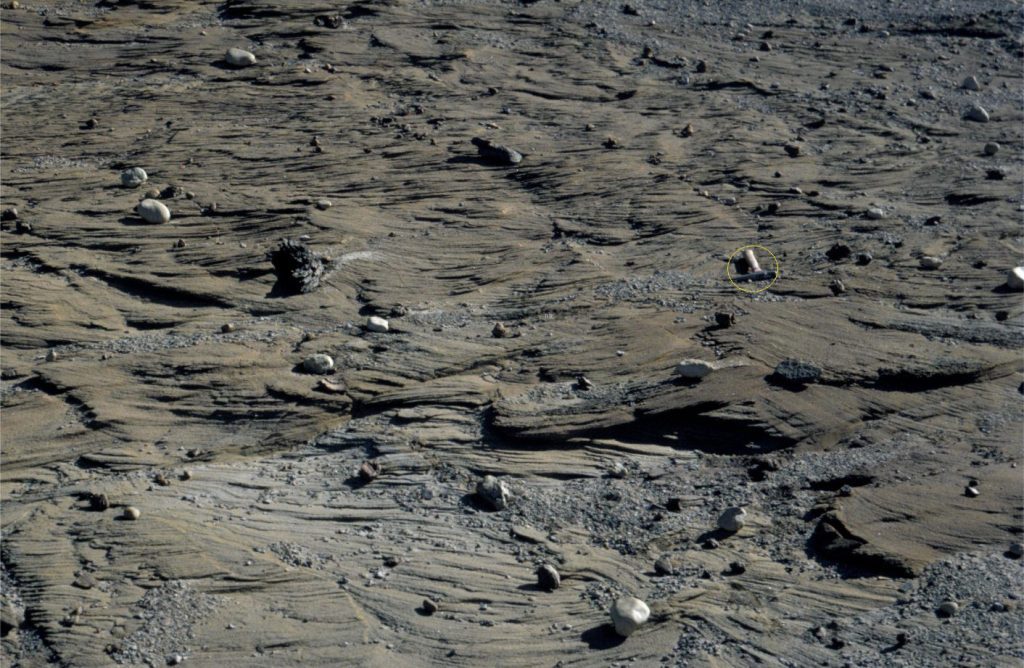

The kind of comparison that never ceases to amaze. Left: Very large, tabular-like crossbedding in the Jurassic Navajo Sandstone, spectacularly exposed at Zion National Park. The dune bedform containing these foresets, at least 18 m high, marched in unison with other dunes across the Middle Jurassic sand-sea. Right: Detail of dune crossbedding in the 3.7 – 2.9 billion year old Stimson formation, probably of aeolian origin, exposed in Gale Crater, Mars (see the recent paper by Banham et al. 2021, Open Access). Contact between crossbed sets is outlined by the dashed line. Note the strongly tangential foresets on lower left. Bar scale is 1 metre. Image credit: enlarged from NASA/JPL-Caltech/MSSS image PIA19818
Trough crossbeds and tabular crossbeds – two common lithofacies
Use this link to read the introduction to the lithofacies series.
General occurrence
Next to ripples, tabular and trough crossbeds are the two most common sedimentary structures you will encounter in sandstones. Unlike the smaller-scale ripples that form in fine-grained sand, tabular and trough crossbeds occur in all grain size grades of sand and gravel, and at scales measured in centimetres to 10s of metres. These two crossbed types occur across the spectrum of aeolian, fluvial, alluvial, and marine depositional environments, from the giant aeolian foresets in the Navajo Sandstone that record blustering winds across the Early Jurassic North American continent, to sand-gravel dune-like bedforms in deep water submarine canyons (e.g., Kaikoura Canyon, east New Zealand; Mountjoy et al., 2018). Tabular and trough crossbeds are important paleocurrent indicators.
Tabular and trough crossbeds are ubiquitous, so much so that they deserve separate lithofacies designations.
Internal structure – tabular crossbeds
The distinction between trough and tabular crossbedding follows McKee and Weir’s (1953) definitions and is based on the geometry of the crossbed set basal contacts and the three-dimensional shape of the foresets.
Tabular crossbed sets have planar basal contacts; in 2D profiles they commonly appear flat. Foresets are also planar to slightly concave (downstream). The contact between foresets and the base varies from abrupt to tangential depending on the relationship between grain size and flow velocity (explained in the paragraph on hydraulics). Foreset contacts at the upper set boundary may also be tangential although erosion by the overlying bedform commonly removes these.
Foreset inclinations vary from 34o in dry sand (aeolian settings), and 15o to 30o in saturated aqueous conditions. In unsaturated but wet sand foreset dips can be as high as 45o because of grain surface cohesion. Foreset thickness also varies according to grain size and the overall size of crossbed sets – from one or two grains thick, to several centimetres in large bedforms.
Grain size grading parallel to foreset dip can also occur where larger clasts accumulate at the base of the foreset, becoming finer grained up-dip. Grain size grading along foresets is more easily identified in large bedforms (decimetres to metres thick), and in sediments having a range of clast sizes. Stacked tabular crossbeds commonly show partial erosion of underlying sets, but the contacts remain relatively flat or planar.


Stacked tabular crossbeds, a record of successive 2D bedform migration across a Cretaceous river channel sand bed (Dunvegan Fm. Alberta). Yellow arrows indicate crossbed set contacts. Foresets in all units have tangential basal contacts (red arrow). Some foresets also have tangential upper contacts and where these occur the foresets present a sinusoidal geometry. Flow was to the left.


Stacked tabular crossbeds above the lens cap, and trough crossbeds below, indicating subtle but important changes in flow velocity. Foreset contacts vary from abrupt to tangential. Flow was to the right. Paleocene Summit Creek Fm. McKenzie River.
Internal structure – trough crossbeds
The basal contacts of trough crossbeds are distinctly curved upward in profile views, and concave or spoon-shaped in 3D views. Foresets are also curved. Other properties such as foreset thickness and grain-size grading follow trends similar to tabular crossbeds. Trough crossbeds frequently occur as cosets (multiple sets) where successive bedforms partly erode previously deposited sets. The basal contacts in all of these are concave. Trough crossbed cosets exposed in two-dimensions on bedding are typically festooned – a term used to describe the arcuate intersections of multiple troughs


Migration of 3D bedforms produced this succession of trough crossbeds in a Middle Eocene, sandy, low sinuosity river (Buchanan Lake Fm. Axel Heiberg Island). Scouring associated with bedform migration resulted in a multitude of discordant crossbed contacts – some are illustrated in the accompanying sketch. Paleoflow was to the left.


Like the preceding image, successive trough crossbeds in this unit are discordant (dashed lines), but here the bedforms developed in much coarser grained channel sediment. Individual crossbeds are much larger – up to 1.5 m thick and laterally more extensive. Each crossbed set represents a stage in the migration of large 3D gravel bars in a low sinuosity (braided) channel. Flow velocities in these channels would have been significantly greater than in the sand-dominated channels illustrated in the preceding photo. Mid-Jurassic Bowser Basin, northern British Columbia.


The exposure of trough cross-stratification on bedding is expressed as festoons of intersecting and overlapping crossbed sets. The curved base and foresets provide an excellent opportunity to measure paleoflow directions on a large number of individual crossbeds, wherein each flow vector bisects the curved foresets. In this example, flow was approximately parallel to the hammer handle towards the top of the photo. Middle Eocene Buchanan Lake Fm. Axel Heiberg Island.
External form
Tabular and trough crossbedding are generated by two types of bedform: two-dimensional and three-dimensional bedforms respectively.
[Note, such bedforms are also called dunes, subaqueous dunes, sandwaves, ripples, megaripples, bars]
Two-dimensional (tabular) bedforms have straight to slightly sinuous crests. They migrate downflow along relatively planar, flattish beds (sand, gravel) as sediment moves down the slip face (lee face). They are designated 2D because they are adequately described by a single profile parallel to the direction of flow (and therefore normal to the crest line). Migration of 2D bedforms produces tabular crossbedding.


Straight crested, tabular dunes formed during an ebb tide. The dune crest azimuths are at a high angle to the shoreline because ebb runoff was diverted along the beach during the late stage of a storm surge. The lee faces (towards the viewer) were also modified by late-stage ebb runoff. Dune amplitudes are 5-8 cm, wavelengths 1.2 to 1.5 m. Raglan, New Zealand.
Three-dimensional bedforms have arcuate or highly sinuous crest lines, and slip (lee) faces that migrate across a scoured, spoon-shaped depression that develops immediately downflow of the lee face; scouring takes place as the bedform migrates. In this case, the bedform geometry requires at least two profiles to capture its overall shape – one parallel to flow and normal to the crest line, and the other at approximately 90o and parallel to the crest line.


Three dimensional subaqueous dunes developed in fine- to medium-grained sand on a tidal flat, Minas Basin. Trough-like or spoon-shaped scours occur downflow of the highly sinuous lee faces. Current ripples developed on the stoss faces during the late stage of ebb runoff as the larger bedforms were exposed. Likewise, horizontal ridges on the lee faces formed as the water level dropped (arrows) and flow was diverted along the bedform troughs. Ebb flow was towards the lower left.
Formation – subaqueous hydraulic conditions


Summaries of the hydraulic conditions for deposition of subaqueous dune bedforms, compared with other bedforms. Data for the graphical plots is mostly from flume experiments.
1- Flow Regime (left); after J.C. Harms & R.K. Fahnestock, 1965,
2- Median grain size and mean current velocities (centre); modified from Ashley, G.M. 1990,
3- Reynolds and Froude numbers as a function of flow depth and flow velocity (right); modified slightly from J.R.L. Allen,1992, Fig. 1.21.
Subaqueous dune fields are indicated in bold red type. In the middle graph, the transition from 2D to 3D bedforms (arrow) is schematic and approximate.
Data from flume experiments and monitoring of natural flow in river and tidal channels, and shallow marine settings indicate that the 2D – 3D morphological separation of bedforms reflects 2D and 3D conditions in flow hydraulics (e.g., Allen, 1985; Ashley, 1990). In general, 2D (tabular) bedforms are generated at lower flow velocities than 3D (trough) bedforms with respect to grain size – as grain size increases, so too does the necessity for higher velocities. Thus, depending on (median or mean) grain size, higher velocities result in higher energy vortices and eddies in front of the lee face, resulting in scour.
Migration of both bedforms takes place in much the same way as smaller ripples with most of the action taking place in the bedload; grains are rolled, jostled or bounced along the (upstream) stoss face, and beyond the crest they cascade down the lee face. Flume experiments have demonstrated that the geometry of foreset basal contacts in 2D bedforms will change from abrupt to increasingly tangential as flow velocities increase. Foresets in 3D bedforms are usually curved and tangential to the sediment bed as they fill the scoured depression.
Both bedforms are included in the upper part of the lower flow regime. Using the terminology of Froude, both bedforms form in subcritical flow conditions; the Froude number for 3D bedforms is usually greater than that for 2D tabular bedforms.
Formation – subaerial hydraulic conditions
The fundamental difference between subaqueous and subaerial depositional conditions lies in the significantly lower fluid density and viscosity. Aeolian bedforms tend to form within a restricted sediment grain-size range compared with subaqueous structures because flow in air exerts much lower magnitude shear stress across the sediment-air interface. Thus, subaerial ripples and larger dunes generally form only in fine- to medium-grained sand.
Notwithstanding these restrictions, the mechanics of bedform initiation and migration are very similar to those developed in subaqueous conditions. Most sand is moved as a traction carpet and a saltation load up the bedform stoss face, subsequently cascading down the lee face. Under dry conditions, the foreset dip is close to the angle of repose – about 34o.
An additional mechanism responsible for moving sand down the subaerial dune lee face involves dry grain flows. Grain flows are usually initiated when the upper part of a lee face is oversteepened during rapid sedimentation, gravitational collapse generating small grain flows. Underlying foresets may be disrupted during this process. Each grain flow event is small and may be difficult to recognise in the rock record.


Multiple tabular crossbeds up to 3 m thick, indicate mainly onshore subaerial dune migration (to the right). Truncation and superposition of dune bedforms was common. The dunes were part of a Pleistocene coastal complex that included large barrier islands bordered along their seaward margins by coastal sand dunes. West Manukau, New Zealand.


A composite image by Mars Curiosity Rover (December 2015) showing the steep front of a large dune that is advancing towards the camera. The streaky forms down the lee face were caused by small sand avalanches – probably grain flows. The dune is about 4m high. It is advancing about 1m per year. Image credits: NASA/JPL-Caltech/MSSS
Common environments
Trough and tabular lithofacies, found together or separately, characterise many terrestrial and shallow marine depositional environments. They are usually included in the various architectural elements and facies models that encapsulate these settings.
Both lithofacies develop where current flow is confined as in fluvial and tidal channels, and unconfined where flow is more sheet-like. There is a propensity for trough crossbeds (3D bedforms) to form in channels because flow velocities there tend to be higher than in unconfined conditions. However, tabular bedforms may also form in channels during lower-flow conditions such as waning flood stages in fluvial environments or waning tidal flows during ebb-flood transitions.
Unconfined tidal flow is typical of continental shelves and platforms. Trough and tabular lithofacies can be observed frequently on sandy tidal flats, and platforms adjacent to tidal channels, although my own observations indicate that the 3D varieties accumulate during tidal flow maxima, and 2D types during the waning stages of ebb or flood tide.
Extensive subaerial and submarine dune fields are well documented in the modern and rock record. For example, subaqueous dunes, or sandwaves commonly develop on continental shelves where there is a sufficient supply of sand. Many of these structures have 2D bedform profiles with relatively straight or slightly sinuous crests. Amplitudes in some are measured in metres and wavelengths in 10s to 100s of metres. In most cases, each sandwave or subaqueous dune is a composite structure, made up of many overlapping, smaller scale bedforms. Many of these subaqueous dune complexes are dynamically linked to sedimentation on the shoreface. They are frequently modified by storms.
Likewise, deserts, ergs, and sand seas are replete with large and small bedforms, most of which are composite structures. And as we have discovered over the last couple of decades, the Martian planet surface has a fascinating variety of subaerial dunes for which our home-grown varieties provide good analogues for Martian bedform geometry and hydraulics.


A mosaic of images of the Stimson formation showing multiple, overlapping and discordant crossbeds, probably deposited as aeolian dunes 3.7 – 2.9 billion years ago in Gale crater, Mars. Most appear to be tabular crossbeds. Detail of tangential foreset geometry in the inset is shown at the top of this page. The scale bar is 2 m long. Imaged by Curiosity, 2015. Image credit: NASA/JPL-Caltech/MSSS
Other posts in the series
Sedimentary lithofacies – An introduction
Ripple lithofacies: Ubiquitous bedforms
Ripple lithofacies influenced by tides
Laminated sandstone lithofacies
Low-angle crossbedded sandstone
Hummocky and swaley cross-stratification
Lithofacies beyond supercritical antidunes
Subaqueous dunes influenced by tides
Introducing coarse-grained lithofacies
